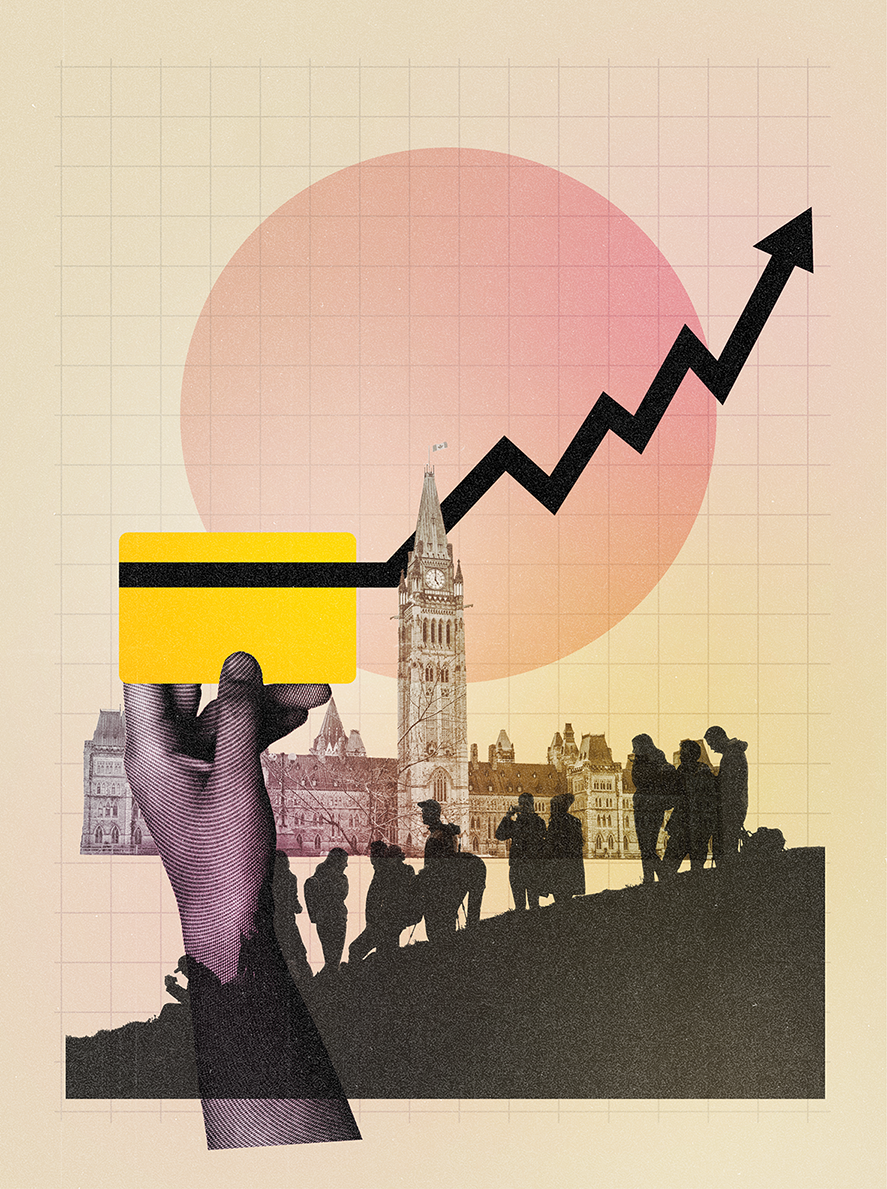If you want to have a lively dinner conversation, ask everyone what they think about the economy and how Canada is performing on the world stage. You may hear an optimistic voice in there somewhere, but it’s more likely the discussion will be dominated by griping about inflation or politics.
Since the pandemic, Canada’s economy has stagnated, according to recent reports. Its productivity is one of the lowest among the G20 nations—Australia is 10 percent more productive per person, and the United States is a whopping 30 percent more productive. While inflation is finally returning to some level of normalcy, consumer confidence remains below historical values.
Our country, however, is on the verge of big changes to our national payment infrastructure. These changes could represent the start of a new era of digital prosperity in Canada and push Canada to the forefront of that prosperity. Just ask Jeremy Wilmot, President and CEO of Interac Corp (Interac).
“Canada is at an inflection moment. We’re on the cusp of something really great,” he notes. “We have an opportunity to bring new services to market over the next few years that could make a significant difference to economic and productivity growth, business potential, people’s lives, and business owners’ lives.”
The bones are there
Despite the current lag in economic growth, Canada’s financial system is robust and well-respected on the global stage. Thanks in part to Interac’s long-standing history of innovation, our digital payment infrastructure is further ahead than what’s available in many advanced economies. Among other features like digital wallets, we have contactless payments that use Interac Debit, and an account-to-account Interac e-Transfer payment system that’s been in place for over twenty years.
“Canada’s financial institutions have been resilient and withstood external pressures that in other markets, like the United States and the UK, buckled under the pressure,” notes David Coletto, founder, Chair and CEO of Abacus Data. “Our banks and our financial system were able to hold it together. We can do things in Canada that they can’t do in other markets. We have the infrastructure in place.”
It’s this infrastructure—the bones, as it were—that’s paving the way for Interac’s three-year strategy as it celebrates its 40th year. Wilmot says the new services planned will address many of the challenges the country currently faces.
These services will help detect and prevent fraud and build consumer trust, enabling small- and medium-sized businesses to operate more efficiently within the financial ecosystem.

The road ahead for Canada is being paved by the high-speed rail of instantaneous payments. This federated national network will turn every customer, every supplier, every merchant into a twenty-four-hour terminal, unlocking a level of personalization hitherto impossible. The full range of financial services that were traditionally the exclusive domain of commercial banks are now enabled as new revenue channels embedded into your digital customer offerings. The future of payments in Canada is around the corner, and I personally cannot wait to see what vibrant new business models will emerge on the backs of this transformative new matrix of exchange.
Scott McDonald,
President, The Future of Money

Trust is essential, but it must be substantiated. You can’t just say to people, “Trust us, we’ll protect your data.” It has to be meaningful. There must be real ways to do this and demonstrate that to the public. That’s why I always talk about the need for strong digital guardrails to protect data and ensure that trust can be grown, because trust is essential to society, to individuals, but it is fleeting right now. We’re trying to build trust at a time when it is being threatened. I want people to have confidence in our society and the online world.
Dr. Ann Cavoukian,
Founder and CEO of Global Privacy & Security by Design and former Information and Privacy Commissioner of Ontario
This will crucially allow businesses to adapt to a changing population as older Canadians retire and younger entrepreneurs and highly skilled newcomers enter the workforce or start their own businesses.
Scott McDonald, Founder and President of The Future of Money conference, sees these innovations as just scraping the surface of what is possible.
“In technology, the best way to know an outcome is to influence it. I think that captures exactly where we are at today in the future of payments in Canada,” he explains. “Instead of sitting on the sidelines as passive observers, the Canadian payments industry is actively building that vision for the world’s best-in-class payments fabric.”
Real-time payments, real-time fraud detection
When sending an Interac e-Transfer to a small business, it’s easy to assume the money disappears from your account immediately and simultaneously reappears in that business owner’s account. However, such is not the case. While the exchange of funds happens almost instantly, the reconciliation process and transfer of funds between two financial institutions could take hours or even overnight, depending on what time of day the payment is made.
A real-time payment system is the answer to that timing issue, allowing for instant money transfer between accounts with zero lag time, helping to increase the efficient flow of money across the economy, and driving GDP growth and productivity. The system has seen success in Brazil, India, and several countries in the Asia-Pacific region, creating new opportunities for businesses and consumers alike, and is currently in development here in Canada. Interac is working with Payments Canada and its other delivery partners, IBM Canada and CGI, to advance the Real-Time Rail (RTR) project.
“The RTR in Canada is slated to be the first countrywide real-time exchange and clearing and settlement system launched with a fraud system that is embedded and part of the release from day one,” notes Wilmot. “Typically, that hasn’t happened around the world as other real-time systems have come on board.”
Wilmot adds that Interac also plans to extend enhanced fraud detection and prevention to its digital payments services, which include Interac e-Transfer and Interac Debit. Part of the answer will be digital verification services like the ones many Canadians typically use when logging into select online government services, but another element of that protection must be artificial intelligence (AI) and machine learning. Together, the ecosystem needs to build solutions that allow for centralized intelligence so we’re not all doing this alone. Using data shared securely across government agencies, banks, telecom companies, and insurance companies, AI will be able to score a transaction in milliseconds. It can do so by comparing it with lists of good or suspicious transaction attributes, as well as bad actors, accounts, emails, and phone numbers connected to previous fraud convictions.
“Instant payment, fraud detection, and making sure that banking and payments are safe, secure, and reliable are super important,” explains Manjit Minhas, CEO & Cofounder of Minhas Brewery, Distillery and Winery. “It makes a big difference not only to people’s buying power but also to their spending power if everybody has technologically advanced tools at their fingertips, which helps our businesses, our economy, and our GDP.”

Every business has to be rooted in technology. You need to start investing in AI and machine learning to do those repetitive tasks quicker, cheaper and more reliably. Everything from invoicing to payments; all the things that aren’t necessarily fun, but everybody’s got to do them. Why not do it with some preciseness, and help your productivity, efficiency, and accuracy? [Digital tools] will need to not have delays. We’re all tired of that, and it hinders so much of people’s growth, but also their risk-taking ability, their understanding of their buying power—a variety of different things.
Manjit Minhas,
CEO & Cofounder of Minhas Brewery, Distillery and Winery

Transparency is going to be really important. Can you be transparent and open about how things are working? We know that over the last twenty to 30 years, more and more consumers want to know where their food comes from and how it’s produced. That doesn’t mean they’re going to go to every farm to inspect it themselves, but they want to know the information is available if they want it and that the food is being sourced ethically and the safety of it is protected. I think the same values and preferences will apply in particular to a digital market.
David Coletto,
founder, Chair and CEO of Abacus Data
Leading Canadians to digital prosperity
Looking into the not-so-distant future, Coletto sees a changing population. The number of Canadians aged eighty-five and older is set to triple in the next 25 years, and in order to boost productivity as boomers age out of the workforce, Canada needs to continue to embrace newcomers. In terms of demographics, that means the most diverse population we’ve ever seen, which he believes is a very good thing.
“If we continue to view it as an opportunity rather than something that makes life harder, it could actually give us an advantage in a global economy and market,” he says, noting the increase in global migration. “Canada, unlike a lot of other countries, has a history of adapting to and prospering with diversity.”
Ensuring this diverse population has the ability to build thriving businesses and participate in and contribute to economic growth is what will put Canada out in front on the global stage. To do that, we all need digital financial tools we can trust. And that’s exactly what Interac is working to provide.
“Our North Star is to lead Canadians toward digital prosperity,” says Wilmot. “Canada’s at this amazing turning point where we could see huge growth in the coming years as more businesses embrace digital tools and innovation. And we genuinely believe that Interac can help make this a reality.”
Visit Interac.ca to learn more.




